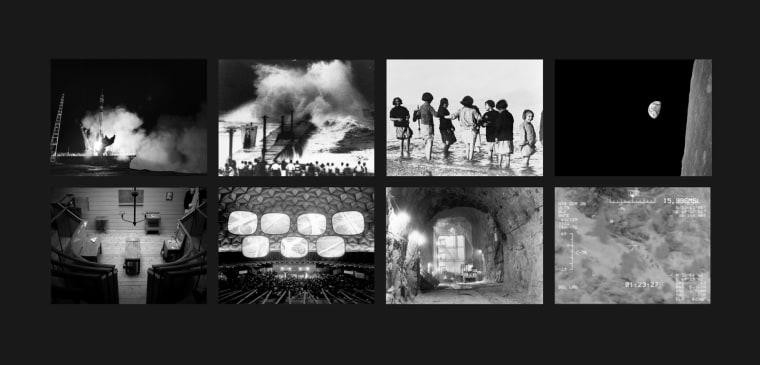A piece of artwork headed into space this week may be on display for the next few billion years.
A collection of images called "The Last Pictures" is hitching a ride on a communications satellite Tuesday that may well orbit the Earth until our planet's predicted fiery death 5 billion years or so from now, according to the the project's creator.
"'The Last Pictures' tells a kind of story to the distant future about where these spacecraft came from and what happened to the people that made them," artist Trevor Paglen, who spent almost five years assembling the collection, told Space.com.
The satellite was set to launch atop a Russian Proton rocket at 1:31 p.m. EST from Baikonur Cosmodrome in Kazakhstan, where the local time will be early Wednesday.
Space trash monuments
Long interested in tracking spacecraft, Paglen realized that geostationary satellites, which hover over the same spot on Earth and spin at the same speed as our planet, have orbits that essentially never decay. Long after they cease to function, they continue to circle the planet at an altitude of 22,300 miles (36,000 kilometers).
"These spacecraft are the longest-lasting things humans have ever made, and potentially ever will make," Paglen said. "I started thinking about them not just as spacecraft, but as monuments to the historical moment they emerged from. When we're gone, they'll still remain." ['The Last Pictures' in Space: Trevor Paglen's Cosmic Art Show (Gallery)]
The first thing Paglen did was have his project manager call every single company that has put a satellite in geostationary orbit.
Ultimately, Paglen ended up making contact with the Ergen family, owners of the EchoStar Corp., a company that owns and manages communication satellites. Chris Ergen, son of owner Charlie, became really excited about the project and got the company behind it, Paglen said.
Paglen, who is an artist-in-residence at the Massachusetts Institute of Technology in Boston, worked with scientists there and at Carleton College in Minnesota to design a method of inscribing the images using nanofabrication techniques that would allow them to last for billions of years.
"As an artist, I had to learn all about rocket science," Paglen said. "Things like, what does a thermal vacuum change, the coefficient of thermal expansion, and all sorts of strange words that are deeply unfamiliar to most of us who aren't in that industry."

With hundreds of defunct satellites and millions of pieces of space junk orbiting the Earth, he also had to think about how to make his project stand out.
"How do we design an object that almost looks like a treasure that someone would want to open up and take a look at?"
The finished project was encased in a gold-plated disc with a "strange starmap" on the exterior, which Paglen said "looked out of place on the host spacecraft."
The project was commissioned and presented by Creative Time, a nonprofit organization that works with public art projects of all disciplines. The communication satellite is called EchoStar 16.
The image of contradiction
"The Last Pictures" is a collection of 100 images Paglen selected after speaking to more than 40 scientists, philosophers, artists and space engineers over the course of several years.
"I was particularly interested in people whose work had to do with some of the contradictions and paradoxes that history and economic development have given us," Paglen said.
The dual nature of things — such as how understanding the interior of stars helped lead to the development of the hydrogen bomb, the pros and cons involved in genetic engineering and the destruction of ecosystems for real estate development — caught his attention.
Whether or not there will be an audience in the future is also a question on which no one agreed. According to Paglen, one participant thinks that people cleaning up space junk in a few hundred years will find it, while others think it won't be found for millions of years.
Paglen, however, doesn't think it will ever be found.
"I think it will orbit Earth forever, until the sun turns into a red giant."
That won't happen for a few billion years, of course. But for Paglen, the prospect of a future audience isn't quite as interesting as the audience that examines the exhibit today. [Earth to Be Consumed by Red Giant (Video)]
"It creates an opportunity for us to think about who we are now, and what we're doing here collectively on Earth," he said.
To that end, Paglen has published a book of the images by the same name, which includes essays about the project and the philosophical questions that it raises.
Paglen thinks a future audience may find the images as mysterious and intriguing as we find ancient cave paintings today.
"We can see them, we can enjoy them. They seem to tell us something about the distant past, but it's unclear exactly what it is they tell us," Paglen said of cave paintings. "What we've done with this project is make cave paintings for the distant future — 21st-century cave paintings."
You can watch the launch live here on Wednesday at 1:31 p.m. ET.
For more information on Paglen's "The Last Pictures" project, visit here.
Follow Space.com on Twitter . We're also on and .
